SBI4U - Final Exam Review PDF

| Title | SBI4U - Final Exam Review |
|---|---|
| Course | Biology |
| Institution | High School - Canada |
| Pages | 7 |
| File Size | 57 KB |
| File Type | |
| Total Downloads | 21 |
| Total Views | 121 |
Summary
Final exam review for grade 12 biology, includes focus questions for review of each topic covered; Teacher: Mr. Leeder...
Description
Grade 12 Biology Exam Review Questions Biochemistry 1. What is an isotope and how is it used in molecular medicine? 2. Based on your knowledge of atoms, electrons and corresponding ions, how does covalent and ionic bonding occur? 3. Why is water considered so important? Outline some properties of water that make it special. 4. What are the main components of the phosopholipid bilayer? How does transport occur through it? 5. Identify 5 main functional groups and explain why they are so important. 6. Compare a hydrolysis reaction with a dehydration synthesis reaction using diagrams. 7. Create a table comparing each of the 4 main macromolecules. Use factors that you think are important. a. Subcategories of macrocmolecules 8. How is energy related to metabolism? 9. How does the first law of thermodynamics relate to activation energy and enthalpy? 10. How does the second law of thermodynamics relate to entropy and free energy? 11. What is ATP? Draw it. 12. Types of reactions…there are 4 13. How is an enzyme like a catalyst? Provide a useful example. 14. How can you regulate enzyme activity? a. Commercial uses of enzymes
Review Questions: Biochemistry P. 196, Q. 1-13, 31, 34, 36
Metabolic Processes
1. How does substrate level phosphorylation compare to oxidative phosphorylation? 2. How does oxidative respiration compare to fermentation? 3. What are the steps and products of cellular respiration? Where does each stage occur? 4. Explain the chemical formula for cellular respiration. 5. Why is ATP added at the beginning of glycolysis? 6. Why is glycolysis present in all living organisms? 7. What are pigments and why are they so important to photosynthesis? 8. Are Priestley’s or Blackman’s experiments more important to our understanding of photosynthesis? 9. How does photosystem I compare to photosystem II?
10. What are the three main steps of the Calvin cycle? 11. What is photorespiration and why is it a bad thing? 12. Compare C3, C4 and CAM plants? Which one is best for our environment? Review Questions: Metabolic Processes p.196 Q. 14-21, 23-30, 33, 34, 35, 37, 38, 43, 46
Molecular Genetics 1. What is DNA. Draw it. 2. Identify and explain three experiments that occurred in the history of genetics and explain why you selected the ones that you did. 3. What did Franklin, Crick, Watson and Wilkins “do” to explain the structure of DNA? 4. How does DNA replication occur? steps? enzymes? leading and lagging strands? 5. How does DNA repair occur? 6. What is the “central dogma” of protein synthesis?
7. Explain what is occurring during initiation, elongation and termination for both transcription and translation. 8. Given a strand of DNA or mRNA- make the correct protein. 9. What is an operon and how does the lac operon work? 10. How do mutations affect living organisms? a. What can cause cancer? b. How are mutations caused by substitution, deletion, addition, inversions and/or jumping genes? 11. Eukaryotic vs. prokaryotic cells → endosymbiosis 12. How are genes organized? 13. What are restriction endonucleases and provide two reasons why are they used. 14. In terms of crime scene investigations how does PCR and gel electrophoresis work? Why are they important? 15. How does isolated DNA get into target areas? 16. How is DNA sequenced? 17. How is RFLP different from gel electrophoresis? How do SNPs come into play? 18. What is CRISPR? What does it do? 19. Explain two applications of biotechnology. 20. What was the purpose and outcomes of the Human Genome Project? What did we learn from this project? Review Questions: Molecular Genetics P. 324, Q. 1-32, 34-37, 40, 41, 44-47
Homeostasis 1. What is homeostasis? 2. How does negative feedback compare to positive feedback? Provide examples. 3. Explain excretion development using 3 examples. 4. What is the nephron and what does it do?
5. What are the three main processes completed during the formation of urine? 6. How does osmoregulation and ADH play into the notion of the importance of water balance? 7. How is pH balance related to our kidneys? 8. Identify three kidney disorders and potential treatments for those disorders. 9. Explain the importance and our development of understanding of hormones. 10. How are insulin OR glucagon examples of homeostasis? 11. How does a steroid hormone compare to a protein hormone? 12. Choose one hormone from the list: Epinephrine, Cortisol, Aldosterone, Thyroxine, Calcitonin, PTH, ACTH, TRH, TSH, Insulin, Glucagon, and ADH. Explain how it functions in maintaining homeostasis in the human body. Include information such as production organ, target organ, direct effect, connection to stress and relation to homeostasis. 13. Compare hormones in the female and male reproductive process. 14. Generally, how does the CNS compare to the PNS? 15. How does an action potential get sent in a reflex arc? 16. Identify two important structures in the spinal cord and three important structures in the brain along with connections between each of the spinal cord and the brain. 17. How does neuro-imaging work? 18. Compare the sympathetic and parasympathetic nervous systems. 19. Discuss the different components of the brain including some specific areas discussed (i.e. Broca and Wernicke) 20. Explain the concept of addictions.
Review Questions: Homeostasis p. 500, Q. 1-15, 24-29, 34-37
Population Dynamics 1.What is a journal article?
2.Why do they have abstracts? 3.What are the success criteria of an abstract? How do we write an abstract? 4.What are bibliometrics? Compare three different types of bibliometrics. Which of the three do you think is the best and why? 5. Be able to discuss one issue related to population dynamics. Ideally it will be the journal article that you completed your close reading for.
Big Picture Questions These are the types of questions that will appear on the final exam. Support your answer(s) using information from as many units as possible. There will be two similar questions on the final exam each being worth 10 marks. ➔ Healthy lifestyle choices can be good for you and the environment. Discuss. ➔ What is genetic engineering? What are the evolutionary and environmental implications of producing new plant and animal varieties by genetic engineering? ➔ You are your enzymes. Discuss. ➔ What are the impacts of bacterial and viral diseases in terms of human evolution, homeostasis and the environment? ➔ What are the evolutionary and environmental implications of allowing the last Truffula seed (from The Lorax) grow and reproduce? ➔ Many herbicides and pesticides are carcinogenic. How can these products affect humans? What are the environmental and evolutionary implications of using these products? ➔ Describe ten things that you learned this year in Grade 12 Biology that will influence your life. ➔ List the risks and benefits from genetically engineered food. Include different stakeholders in your answer. ➔ How did you think scientific discoveries were made BEFORE you started this course? How have your views changed after learning about the discovery of DNA, PCR or DNA fingerprinting? ➔ Initial reluctance among the scientific community to accept that DNA was the molecule forming genes (carrying a great deal of information stemmed to some extend from the knowledge that DNA was a relatively simple molecule made up of only four nucleotides. Briefly explain how DNA is capable of encoding a great deal of information, in spite of its apparently simple structure.
➔ How does DNA determine how you look and behave? ➔ Peter Parker was transformed into Spiderman after being bitten by a genetically modified spider. Is this possible? Why? Why not? ➔ How does your DNA determine how you behave? (based on what we discussed in class) ➔ Can we genetically engineer humans at the present time? Explain. ➔ Should we genetically engineer humans? Why?* ➔ What are some of the factors responsible for world hunger? (3 factors) ➔ What are the primary dangers of transgenic crops? ➔ What are the benefits of transgenic crops? ➔ Are you concerned about our food supply? Why? ➔ Describe one analogy (other than a furnace) to represent homeostasis. ➔ Do you think that using drugs to control homeostasis is a good thing? Why? (Use one example in your answer) ➔ Are all fats bad for you? Why? ➔ What is the best diet for you based on class information? ➔ Should you take a vitamin/mineral supplement? Why? (Provide specific details about your diet to support your answer). ➔ Should we use antibacterial products? Why? ➔ Should we be concerned about the bird flu virus? Why? ➔ What analogy could you use to describe the geological time scale and the emergence of different life forms? ➔ Is there a biological basis for race? Why? ➔ What should you eat and drink to maintain maximum performance? Why ➔ What can you do to reduce your environmental impact? ➔ What should you consider when deciding what products to buy in terms of their life cycle? ➔ Should corporations be responsible for the waste they produce? Why? Why not?...
Similar Free PDFs

SBI4U - Final Exam Review
- 7 Pages

Chem Final Exam Review
- 12 Pages

Final Exam - Review notes
- 92 Pages

Bio Final Exam Review
- 2 Pages

Final EXAM Review booklet
- 5 Pages
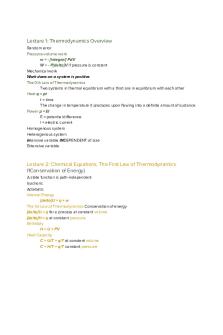
CHEM303 final exam review
- 4 Pages

Psychology Final Exam - Review
- 13 Pages
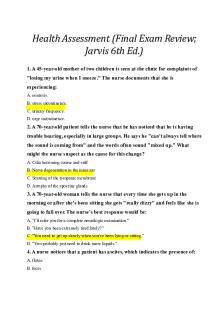
Jarvis Final Exam Review
- 12 Pages
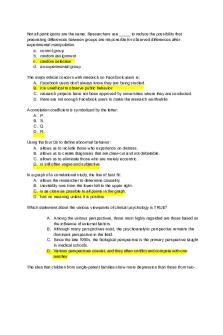
Final exam review
- 96 Pages
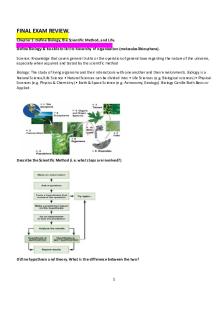
Final Exam Review
- 48 Pages
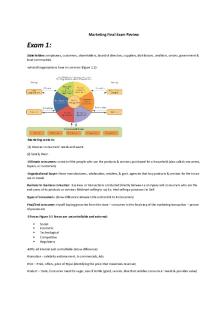
Marketing Final Exam Review
- 15 Pages
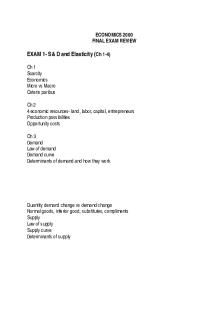
Final exam review
- 8 Pages
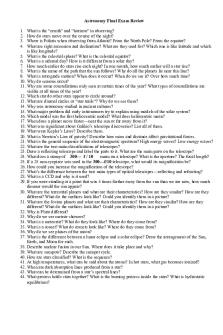
Astronomy Final Exam Review
- 2 Pages
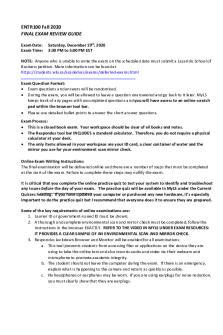
Final Exam Review Guide
- 4 Pages

Final exam review flsp4420
- 5 Pages

Theo Final Exam Review
- 16 Pages
Popular Institutions
- Tinajero National High School - Annex
- Politeknik Caltex Riau
- Yokohama City University
- SGT University
- University of Al-Qadisiyah
- Divine Word College of Vigan
- Techniek College Rotterdam
- Universidade de Santiago
- Universiti Teknologi MARA Cawangan Johor Kampus Pasir Gudang
- Poltekkes Kemenkes Yogyakarta
- Baguio City National High School
- Colegio san marcos
- preparatoria uno
- Centro de Bachillerato Tecnológico Industrial y de Servicios No. 107
- Dalian Maritime University
- Quang Trung Secondary School
- Colegio Tecnológico en Informática
- Corporación Regional de Educación Superior
- Grupo CEDVA
- Dar Al Uloom University
- Centro de Estudios Preuniversitarios de la Universidad Nacional de Ingeniería
- 上智大学
- Aakash International School, Nuna Majara
- San Felipe Neri Catholic School
- Kang Chiao International School - New Taipei City
- Misamis Occidental National High School
- Institución Educativa Escuela Normal Juan Ladrilleros
- Kolehiyo ng Pantukan
- Batanes State College
- Instituto Continental
- Sekolah Menengah Kejuruan Kesehatan Kaltara (Tarakan)
- Colegio de La Inmaculada Concepcion - Cebu